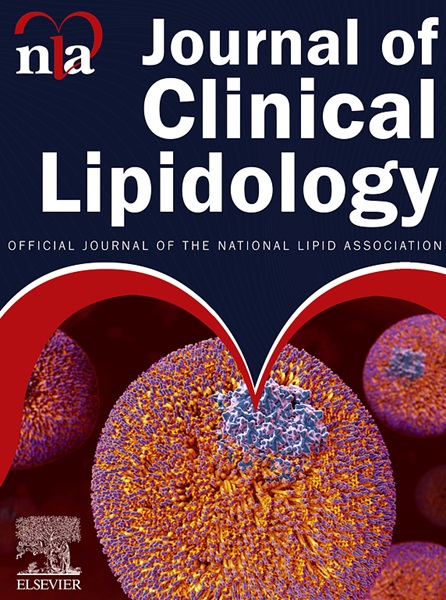急性冠脉综合征患者残余胆固醇与罪魁祸首血管生理特征的关系:一项光学相干断层扫描研究
IF 4.6
3区 医学
Q2 PHARMACOLOGY & PHARMACY
引用次数: 0
摘要
背景:富甘油三酯脂蛋白(TRLs)中的残余胆固醇(RC)与动脉粥样硬化性心血管疾病(ASCVD)密切相关。然而,其与急性冠脉综合征(ACS)患者罪魁血管生理特征的关系尚不清楚。目的:探讨ACS患者RC与罪魁血管生理特征的关系。方法:本研究回顾性纳入657例行光学相干断层扫描(OCT)检查的ACS患者。患者根据RC指标分为3组。使用OCT自动识别软件对OCT图像进行分析,识别斑块组成、最小管腔面积(MLA)、最小纤维帽厚度、最大脂质角和功能参数光流比(OFR)。结果:RC水平较高的患者表现出更大的脂质斑块体积(22.43 vs 26.20 vs 29.53;P = .002)和较低的OFR (0.74 vs 0.82 vs 0.84;P < 0.001)。升高的RC被确定为OFR≤0.8的独立预测因子(每1单位增加的优势比:2.364,95% CI: 1.491-3.748, P < 0.001)。将RC纳入基线模型增强了其对OFR≤0.8的预测值,将曲线下面积(AUC)从0.641 (95% CI: 0.598-0.683)增加到0.720 (95% CI: 0.681-0.758);P < 0.001)。结论:ACS患者的RC与潜在的严重心肌缺血和易损斑块存在显著正相关。本文章由计算机程序翻译,如有差异,请以英文原文为准。
Association between remnant cholesterol and culprit vessel physiological features in patients with acute coronary syndrome: An optical coherence tomography study
BACKGROUND
Remnant cholesterol (RC) in triglyceride-rich lipoproteins (TRLs) is strongly associated with atherosclerotic cardiovascular disease (ASCVD). However, its relationship with the physiological features of the culprit vessel in patients following acute coronary syndrome (ACS) remains unclear.
OBJECTIVE
To explore the relationships between RC and the culprit vessel physiological features in ACS patients.
METHODS
This study retrospectively enrolled 657 patients with ACS who underwent optical coherence tomography (OCT) examination. The patients were divided into 3 groups based on RC tertiles. OCT images were analyzed using OCT automatic recognition software, which identified plaque composition, minimum lumen area (MLA), minimum fibrous cap thickness, maximum lipid angle, and a functional parameter, the optical flow ratio (OFR).
RESULTS
Patients with higher RC levels exhibited larger lipid plaque volumes (22.43 vs 26.20 vs 29.53; P = .002) and lower OFR (0.74 vs 0.82 vs 0.84; P < .001) compared to those with lower RC levels. Elevated RC was identified as an independent predictor of OFR ≤0.8 (odds ratio per 1-unit increase: 2.364, 95% CI: 1.491-3.748, P < .001). Incorporating RC into a baseline model enhanced its predictive value for OFR ≤0.8, increasing the area under the curve (AUC) from 0.641 (95% CI: 0.598-0.683) to 0.720 (95% CI: 0.681-0.758; P < .001).
CONCLUSIONS
There is a significantly positive relationship between the RC and potentially severe myocardial ischemia and the vulnerable plaques in patients with ACS.
求助全文
通过发布文献求助,成功后即可免费获取论文全文。
去求助
来源期刊
CiteScore
7.00
自引率
6.80%
发文量
209
审稿时长
49 days
期刊介绍:
Because the scope of clinical lipidology is broad, the topics addressed by the Journal are equally diverse. Typical articles explore lipidology as it is practiced in the treatment setting, recent developments in pharmacological research, reports of treatment and trials, case studies, the impact of lifestyle modification, and similar academic material of interest to the practitioner.
Sections of Journal of clinical lipidology will address pioneering studies and the clinicians who conduct them, case studies, ethical standards and conduct, professional guidance such as ATP and NCEP, editorial commentary, letters from readers, National Lipid Association (NLA) news and upcoming event information, as well as abstracts from the NLA annual scientific sessions and the scientific forums held by its chapters, when appropriate.

 求助内容:
求助内容: 应助结果提醒方式:
应助结果提醒方式:


